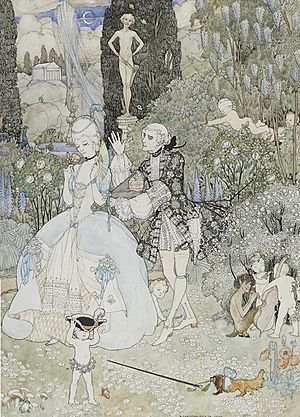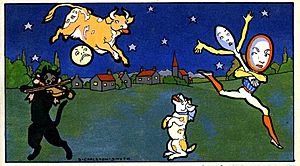Dorothy Carleton Smyth facts for kids
Dorothy Carleton Smyth (born 1880, died 1933) was a talented Scottish artist. She was known for her amazing work in theatre and costume design. Dorothy was a very important person at the Glasgow School of Art after World War I. She was also part of the Arts & Crafts Movement, which focused on beautiful, handcrafted items. Her skills in book illustration and leading roles at the Glasgow School of Art made her a key figure in the "Golden Age of Illustration." In 1933, she was chosen to be the first female director of the Glasgow School of Art. Sadly, she passed away that same year, which was a great loss for Scottish art.
Quick facts for kids
Dorothy Smyth
|
|
|---|---|

Self-portrait, age 41 (1921) oil on canvas
|
|
| Born | 1 March 1880 |
| Died | 15 February 1933 (aged 52) Cambuslang, Scotland
|
| Education | Manchester School of Art, 1892-1893 Glasgow School of Art, 1898-1902 |
| Known for | Theatre, Costume Design |
| Movement | Arts and Crafts Movement Golden Age of Illustration |
Contents
Early Life and Family
Dorothy Smyth was born in 1880 in Cambuslang, a town near Glasgow, Scotland. Her father, William Hugh Smyth, made jute, a type of fiber. Her family moved to Manchester, England, in the 1880s.
Dorothy wasn't the only artist in her family. Her sister, Olive (born 1882), also became an artist and later taught at the Glasgow School of Art. Another sister, Rose, became a composer.
Learning About Art: The Arts & Crafts Movement
Dorothy went to school in Manchester, including the Manchester High School for Girls. From 1893 to 1897, she studied art at the Manchester School of Art. There, she learned from a famous artist named Walter Crane.
Crane was a big supporter of the Arts & Crafts Movement. This movement believed that art should be part of everyday life. Artists should use their skills to create beautiful books, clothing, and other handcrafted items.
Dorothy's early work showed her talent. She designed covers for special, handcrafted books, like The Poems of Alfred, Lord Tennyson and The Jungle Book. These books were very fancy, with detailed, hand-colored covers. This work fit perfectly with the ideas of the Arts and Crafts Movement.
The Arts and Crafts Movement also encouraged artists to connect with their local culture. So, when Dorothy was 18, she decided to return to Scotland. She continued her art studies at the Glasgow School of Art (GSA).
By the time she started at GSA in 1898, Dorothy was very interested in theatre and costume design. She loved "exotic clothes" and often helped with student plays and shows at the school.
Her Career as an Artist
Dorothy Smyth's art had a unique and elegant style, similar to Art Nouveau. Even before she graduated, her stained glass window called Tristan and Iseult was shown at the Glasgow International Exhibition in 1901.
After she graduated from GSA in 1902, a kind person paid for her to join the Glasgow Society of Lady Artists. This allowed her to travel to places like Florence, Paris, and Switzerland. She studied the works of famous European artists there.
In 1903, Dorothy was asked to show her art in several cities, including Turin, Cork, Toronto, and Budapest. Later that year, she met F.R. Benson, a theatre producer. He hired Dorothy to design costumes for his touring theatre company. For the next ten years, she traveled and created amazing costumes.
Touring with Theatre Companies
Dorothy designed costumes for many Shakespearean plays. She worked on shows for Benson's company and other theatre groups. She also created costumes for big public events and "tableaux," which were like living pictures.
Even while traveling, Dorothy stayed connected to Glasgow. In 1912, she helped organize a holiday event there. She also worked for the Glasgow Repertory Company and the Quinlan Opera Company.
With her sister Olive and other female artists, Dorothy helped start the Sister Studios. This place offered classes in different crafts, like metalwork and embroidery. This experience helped Dorothy gain important management skills. These skills would be very useful when she returned to Glasgow to teach at her old school.
Gallery: Theatrical Costumes
Teaching and Illustration Work
In 1914, Dorothy returned to the Glasgow School of Art to teach. At the same time, she continued her work as a professional artist. She created "book illustrations, sculptures, silverwork and portraits" for businesses and individuals.
Leading Roles at GSA
In 1927, Dorothy was made the head of the Commercial Art Department at GSA. She held this position until 1933.
In early 1933, Dorothy was offered the top job: Director of the Glasgow School of Art. This was a huge honor, as she was likely the first woman to be offered such a high position in a higher education art school. Dorothy accepted the role. However, just over a month later, she sadly passed away from a brain hemorrhage.
Her Legacy
Dorothy Smyth lived with her sisters for most of her life. Her sister Olive Smyth also taught fashion at GSA during this time.
In 1921, when she was 41, Dorothy painted a Self Portrait. This painting shows her in her art studio, smiling, with her brushes and paint. Olive Carleton Smyth later gave this painting to the Glasgow Museums in 1948.
After Dorothy's death in 1933, W.O. Hutchinson became the Director of GSA. People often wonder what the school would have been like if Dorothy had been able to lead it for longer. She was highly praised for her work and teaching.
Dorothy was also supported by Fra Newbury, a well-known figure in the art world. Her group of artists is now often called the 'Glasgow Girls'.
Images for kids












